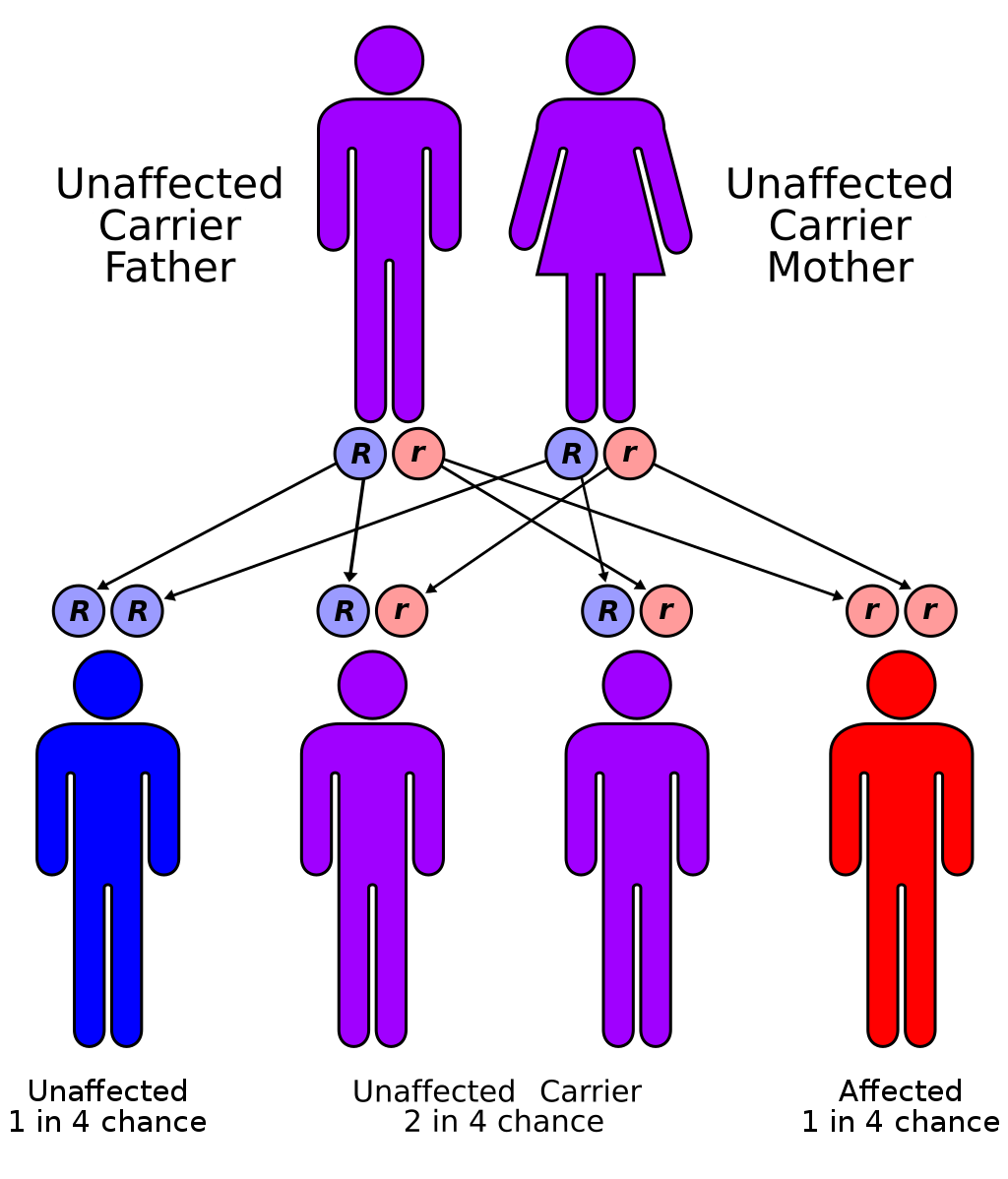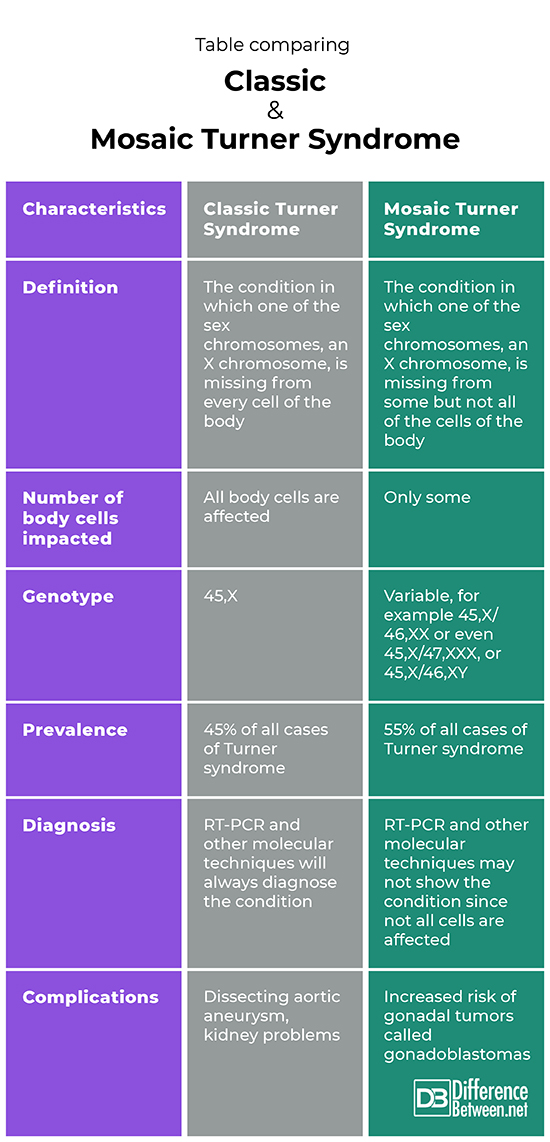Difference Between Classic and Mosaic Turner Syndrome
Classic Turner syndrome is the condition in which one of the sex chromosomes is missing from every cell. Mosaic Turner syndrome is the condition in which a sex chromosome is missing from some but not all the cells.
What is Classic Turner Syndrome?
Definition:
Classic Turner syndrome is the condition in which one of the chromosomes that determine gender is missing. The sex chromosomes are X and Y with a normal human female individual having XX and a normal male individual having XY. With classic Turner syndrome, every cell has 45,X chromosomes. In classic Turner syndrome, one of the sex chromosomes is missing from every cell of the body.
Causes:
Turner syndrome results from an error that happens during spermatogenesis or oogenesis in which one of the X chromosomes is not separated into a cell. This mistake is called nondisjunction and it happens during the meiotic cell division. Turner syndrome is also often called monosomy X since only one of the X chromosomes is passed into the cell being formed in meiosis.
Diagnosis:
Fetuses can be diagnosed during prenatal counseling and through RT-PCR methods or karyotype analysis in which the fetal chromosomes are examined. In the past diagnosis was based mainly on the symptoms that the person had and the fact that no sexual development occurred at puberty. This means no breast development or menstruation occurred.
Symptoms:
People with Turner syndrome have female traits but genitalia are not properly formed and very rudimentary. The ovaries also are not properly developed and are only pieces of connective tissue. Patients with Turner syndrome also have a webbed neck, skin folds in the corners of the eyes, and low-set ears. They may have a small chin and no breasts develop at puberty. There are often problems with the heart and large blood vessels of the body.
Treatment:
Individuals who have Turner syndrome can be given estrogen and progestin as well as growth hormones to help them develop at puberty and to grow taller.
Complications:
The condition does cause infertility since the reproductive organs do not develop normally. People with Turner syndrome also often have issues with the aorta (the main artery of the body) and the aortic valve which occurs inside the heart. Kidney problems occur in about 1/3 of people with the condition and problems of low thyroid activity are common. Patients with Turner syndrome have an increased risk of having a dissecting aortic aneurysm, which can prove fatal.
What is Mosaic Turner Syndrome?
Definition:
Mosaic Turner syndrome is when some, but not all of the cells of the individual having Turner’s syndrome have an unusual combination of sex chromosomes. There is a lot of variation in this regard, with some individuals having cells that are 45,X but in other cases they may even have some cells that are XY and some that are 45,X.
Causes:
The cause of mosaic Turner syndrome is some type of error that occurs during cell division, leading to abnormalities in the chromosomes of some but not all of the cells.
Diagnosis:
Diagnosis of mosaic Turner syndrome may be more difficult since not all the cells have a chromosomal abnormality. However, the presence of the features seen in Turner syndrome may be present and the chromosome abnormality may sometimes be detected with molecular methods such as RT-PCR and using karyotypes. In some variants of mosaic Turner syndrome, the individual may be born with ambiguous genitalia which may also indicate a chromosomal issue. Some of the cells are normal in terms of chromosomes, but others are not.
Symptoms:
Some females with mosaic Turner syndrome can have eye problems and in fact, have problems with the development of the eye called anterior segment dysgenesis. Many of the typical features of Turner syndrome are present including the short stature, low set eyes, and webbed neck. Similar organ problems may be present an in some variations, the genitalia may be ambiguous. Mixed gonadal dysgenesis (MGD) is another problem that can occur in which some testicular tissue may be present along with streaks of ovary tissue. This condition is linked to a specific gene called SRY.
Treatment:
Individuals with Turner syndrome can be treated with growth hormones to encourage growth and hormone treatments at puberty. Researchers have also suggested that in some cases, such as in the presence of the SRY gene that removal of gonadal tissue is recommended to reduce the risk of gonadoblastoma.
Complications:
Some individuals who have mosaic Turner syndrome have an increased risk of gonadoblastoma, which is a tumor of the reproductive tissues.
Difference between Classic and Mosaic Turner syndrome
Definition
Classic Turner syndrome is the disorder in which one of the X chromosomes is missing from every cell of the body. Mosaic Turner syndrome is the disorder in which usually one of the X chromosomes is missing from some of the cells of the body.
Number of body cells impacted
In classic Turner syndrome, all the cells of the body are affected while in mosaic Turner syndrome only some of the cells are affected.
Genotype
The genotype of classic Turner syndrome does not vary and is 45,X. The genotype of mosaic Turner syndrome is very variable and can be any of the following: 45,X/ 46,XX or even 45,X/47,XXX, or 45,X/46,XY.
Prevalence
The classic Turner syndrome is found in about 45% of Turner cases. The mosaic Turner syndrome is found in about 55% of Turner cases.
Diagnosis
RT-PCR and other molecular techniques will always diagnose classic Turner condition. The RT-PCR and other molecular techniques do not always diagnose mosaic Turner condition immediately because the problem is only in some of the cells.
Complications
Common complications of classic Turner syndrome include dissecting aortic aneurysm and kidney problems. Complications of mosaic Turner syndrome include gonadoblastomas in certain genotypes.
Table comparing Classic and Mosaic Turner syndrome
Summary of Classic Vs. Mosaic Turner syndrome
- People who have classic and mosaic Turner syndrome can have similar features such as short stature and failure of reproductive tissue to develop.
- Both types of Turner syndrome are due to errors associated with the sex chromosomes.
- Individuals with classic Turner syndrome s are always 45,X genotype in all their cells.
- Mosaic Turner has many genotype variants, with some individuals showing ambiguity in reproductive organs and genitalia.
- Difference Between Rumination and Regurgitation - June 13, 2024
- Difference Between Pyelectasis and Hydronephrosis - June 4, 2024
- Difference Between Cellulitis and Erysipelas - June 1, 2024
Search DifferenceBetween.net :
Leave a Response
References :
[0]Image credit: https://en.wikipedia.org/wiki/Cockayne_syndrome#/media/File:Autorecessive.svg
[1]Image credit: https://en.wikipedia.org/wiki/Holt%E2%80%93Oram_syndrome#/media/File:Autosomal_dominant_-_en.svg
[2]Powell-Hamilton, Nina N. “Turner syndrome.”Chromosome and gene anomalies”. Merck & Co., 2018, https://www.msdmanuals.com/professional/pediatrics/chromosome-and-gene-anomalies/turner-syndrome
[3]US Department of Health and Human Services. "What causes Turner syndrome?” NIH, 2019, https://www.nichd.nih.gov/health/topics/turner/conditioninfo/causes
[4]Zhong, Quincy, and Lawrence C. Layman. "Genetic considerations in the patient with Turner syndrome—45, X with or without mosaicism." Fertility and sterility 98.4 (2012): 775-779.



